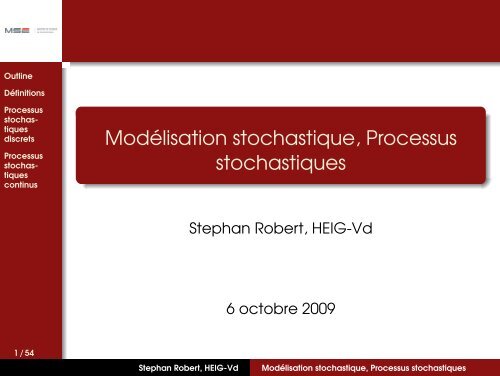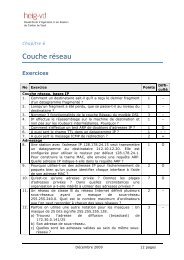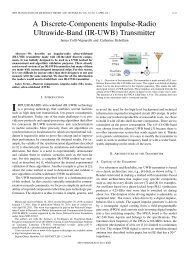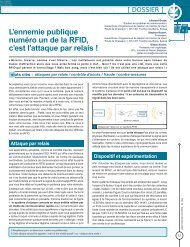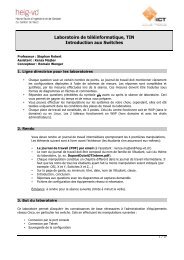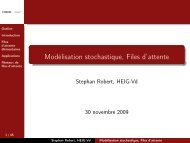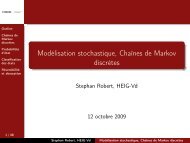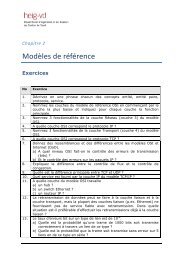Modélisation stochastique, Processus stochastiques - Dr Stephan ...
Modélisation stochastique, Processus stochastiques - Dr Stephan ...
Modélisation stochastique, Processus stochastiques - Dr Stephan ...
Create successful ePaper yourself
Turn your PDF publications into a flip-book with our unique Google optimized e-Paper software.
Outline<br />
Définitions<br />
<strong>Processus</strong><br />
<strong>stochastique</strong>s<br />
discrets<br />
<strong>Processus</strong><br />
<strong>stochastique</strong>s<br />
continus<br />
Modélisation <strong>stochastique</strong>, <strong>Processus</strong><br />
<strong>stochastique</strong>s<br />
<strong>Stephan</strong> Robert, HEIG-Vd<br />
6 octobre 2009<br />
1 / 54<br />
<strong>Stephan</strong> Robert, HEIG-Vd<br />
Modélisation <strong>stochastique</strong>, <strong>Processus</strong> <strong>stochastique</strong>s
Outline<br />
Définitions<br />
<strong>Processus</strong><br />
<strong>stochastique</strong>s<br />
discrets<br />
<strong>Processus</strong><br />
<strong>stochastique</strong>s<br />
continus<br />
1 Définitions<br />
2 <strong>Processus</strong> <strong>stochastique</strong>s discrets<br />
3 <strong>Processus</strong> <strong>stochastique</strong>s continus<br />
2 / 54<br />
<strong>Stephan</strong> Robert, HEIG-Vd<br />
Modélisation <strong>stochastique</strong>, <strong>Processus</strong> <strong>stochastique</strong>s
Rappel : Variables aléatoires<br />
Outline<br />
Définitions<br />
<strong>Processus</strong><br />
<strong>stochastique</strong>s<br />
discrets<br />
<strong>Processus</strong><br />
<strong>stochastique</strong>s<br />
continus<br />
Exemple : Pièce de monnaie soit jetée trois fois.<br />
X(ω) : Nombre de faces.<br />
Ω = {FFF, FFP, FPF, PFF, FPP, PFP, PPF, PPP}<br />
Pour chaque issue ω ∈ Ω, X(ω) ∈ {0, 1, 2, 3}.<br />
on a<br />
X({PPP}) = 0<br />
X({FPP}) = X({PFP}) = X({PPF}) = 1<br />
X({FFP}) = X({FPF}) = X({PFF}) = 2<br />
X({FFF}) = 3<br />
3 / 54<br />
<strong>Stephan</strong> Robert, HEIG-Vd<br />
Modélisation <strong>stochastique</strong>, <strong>Processus</strong> <strong>stochastique</strong>s
<strong>Processus</strong> <strong>stochastique</strong>s<br />
Outline<br />
Définitions<br />
<strong>Processus</strong><br />
<strong>stochastique</strong>s<br />
discrets<br />
<strong>Processus</strong><br />
<strong>stochastique</strong>s<br />
continus<br />
Variable aléatoire dépendant du temps : X t (ω)<br />
<strong>Processus</strong> <strong>stochastique</strong> : X = (X t (ω) : t ∈ T),<br />
Discret si T = N = {0, 1, 2, 3, ...} ou T = Z = {..., −2,<br />
−1, 0, 1,<br />
Continu si T = R ou T = R +<br />
Remarque : Le processus peut être à “états discrets”<br />
ou à “états continus”.<br />
Notation d’un processus discret : X = (X n : n ∈ Z) ou<br />
X = (X n : n ∈ N)<br />
4 / 54<br />
Exemple : Pièce de monnaie soit jetée n fois :<br />
<strong>Processus</strong> discret à états discrets.<br />
<strong>Stephan</strong> Robert, HEIG-Vd<br />
Modélisation <strong>stochastique</strong>, <strong>Processus</strong> <strong>stochastique</strong>s
<strong>Processus</strong> <strong>stochastique</strong>s (2)<br />
Outline<br />
Définitions<br />
<strong>Processus</strong><br />
<strong>stochastique</strong>s<br />
discrets<br />
<strong>Processus</strong><br />
<strong>stochastique</strong>s<br />
continus<br />
<strong>Processus</strong> <strong>stochastique</strong> : X = (X t (ω) : t ∈ T)<br />
Remarques :<br />
Si “t” ou “n” est fixé, Le processus <strong>stochastique</strong> est<br />
une variable aléatoire.<br />
Si ω ∈ Ω est fixé, nous avons une fonction du temps.<br />
5 / 54<br />
<strong>Stephan</strong> Robert, HEIG-Vd<br />
Modélisation <strong>stochastique</strong>, <strong>Processus</strong> <strong>stochastique</strong>s
Exemple processus <strong>stochastique</strong> discret<br />
Outline<br />
Définitions<br />
<strong>Processus</strong><br />
<strong>stochastique</strong>s<br />
discrets<br />
<strong>Processus</strong><br />
<strong>stochastique</strong>s<br />
continus<br />
<strong>Processus</strong> de Bernoulli : X = (X n : n ∈ N) est une<br />
collection de variables aléatoires indépendantes avec<br />
P(X n = 1) = p et P(X n = 0) = 1 − p, 0 ≤ p ≤ 1.<br />
FIGURE: Séquence particulière d’un processus de Bernoulli<br />
6 / 54<br />
<strong>Stephan</strong> Robert, HEIG-Vd<br />
Modélisation <strong>stochastique</strong>, <strong>Processus</strong> <strong>stochastique</strong>s
Exemples (2)<br />
Outline<br />
Définitions<br />
<strong>Processus</strong><br />
<strong>stochastique</strong>s<br />
discrets<br />
<strong>Processus</strong><br />
<strong>stochastique</strong>s<br />
continus<br />
Remarque : L’espace fondamental doit être<br />
suffisamment grand ({0, 1} N si n = 0, 1, 2, ..., N) pour<br />
comprendre toutes les séquences possibles car à<br />
chaque ω doit correspondre une séquence (par<br />
exemple 010111... comme montré à la figure<br />
précédente).<br />
Exemple : {Y n , n ≥ 1} indépendantes avec<br />
P(Y n = 1) = p<br />
P(Y n = −1) = 1 − p<br />
Marche aléatoire ("random walk") :<br />
7 / 54<br />
X = (X n = ∑ n<br />
i=1 Y i) avec n ≥ 1<br />
<strong>Stephan</strong> Robert, HEIG-Vd<br />
Modélisation <strong>stochastique</strong>, <strong>Processus</strong> <strong>stochastique</strong>s
Espérance mathématique<br />
Outline<br />
Définitions<br />
<strong>Processus</strong><br />
<strong>stochastique</strong>s<br />
discrets<br />
<strong>Processus</strong><br />
<strong>stochastique</strong>s<br />
continus<br />
<strong>Processus</strong> discret à états discrets :<br />
E(X n ) = µ X (n) = ∑ ∞<br />
−∞ x i.P(X n = x i )<br />
<strong>Processus</strong> discret à états continus :<br />
E(X n ) = µ X (n) = ∫ ∞<br />
−∞ x.f X(x, n)dx<br />
8 / 54<br />
<strong>Stephan</strong> Robert, HEIG-Vd<br />
Modélisation <strong>stochastique</strong>, <strong>Processus</strong> <strong>stochastique</strong>s
Exemple<br />
Outline<br />
Définitions<br />
<strong>Processus</strong><br />
<strong>stochastique</strong>s<br />
discrets<br />
<strong>Processus</strong><br />
<strong>stochastique</strong>s<br />
continus<br />
Marche aléatoire :<br />
Nous avons<br />
X n = ∑ n<br />
i=1 Y i, n ≥ 1,<br />
P(Y n = 1) = p<br />
P(Y n = −1) = 1 − p<br />
9 / 54<br />
donc<br />
E[X n ] = E[ ∑ n<br />
i=1 Y i] =<br />
E[Y 1 ] + ... + E[Y n ] = n.E[Y 1 ]=<br />
n(1 ∗ p + (−1) ∗ (1 − p)) =<br />
n(2p − 1)<br />
<strong>Stephan</strong> Robert, HEIG-Vd<br />
Modélisation <strong>stochastique</strong>, <strong>Processus</strong> <strong>stochastique</strong>s
Corrélation<br />
Outline<br />
Définitions<br />
<strong>Processus</strong><br />
<strong>stochastique</strong>s<br />
discrets<br />
<strong>Processus</strong><br />
<strong>stochastique</strong>s<br />
continus<br />
Fonction d’autocorrélation : Espérance mathématique<br />
du produit : X m X n<br />
R XX (m, n) = R X (m, n) = E[X m .X n ] =<br />
E[X n .X m ] = R X (n, m)<br />
10 / 54<br />
<strong>Stephan</strong> Robert, HEIG-Vd<br />
Modélisation <strong>stochastique</strong>, <strong>Processus</strong> <strong>stochastique</strong>s
Corrélation (2)<br />
Outline<br />
Définitions<br />
<strong>Processus</strong><br />
<strong>stochastique</strong>s<br />
discrets<br />
<strong>Processus</strong><br />
<strong>stochastique</strong>s<br />
continus<br />
Observations :<br />
R X (n, n) = E[X n .X n ] = E[X 2 n] ≥ 0 si n = m.<br />
E[X 2 n] représente la puissance moyenne de X n (ou<br />
de X m ).<br />
Fonction de corrélation : R XY (m, n) = E[X m Y n ]<br />
11 / 54<br />
<strong>Stephan</strong> Robert, HEIG-Vd<br />
Modélisation <strong>stochastique</strong>, <strong>Processus</strong> <strong>stochastique</strong>s
Exemple<br />
Outline<br />
Définitions<br />
<strong>Processus</strong><br />
<strong>stochastique</strong>s<br />
discrets<br />
<strong>Processus</strong><br />
<strong>stochastique</strong>s<br />
continus<br />
12 / 54<br />
Auto-corrélation d’une marche aléatoire<br />
Nous avons R X (m, n) = E[X m .X n ]<br />
En remplaçant les variables aléatoires<br />
X n = ∑ n<br />
i=1 Y i = ∑ n<br />
i=0 Y i, Y 0 = 0, nous trouvons<br />
m∑<br />
E[X m .X n ] = E[ Y i .<br />
=<br />
=<br />
m∑<br />
i=0<br />
i=0 j=0<br />
min(n,m)<br />
∑<br />
i=0<br />
<strong>Stephan</strong> Robert, HEIG-Vd<br />
n∑<br />
Y j ]<br />
j=0<br />
n∑<br />
E[Y i Y j ]<br />
E[Y 2 i ] + n∑<br />
m∑<br />
i=0 j=0,j≠i<br />
E[Y i ]E[Y j ]<br />
Modélisation <strong>stochastique</strong>, <strong>Processus</strong> <strong>stochastique</strong>s
Exemple (2)<br />
Outline<br />
Définitions<br />
<strong>Processus</strong><br />
<strong>stochastique</strong>s<br />
discrets<br />
<strong>Processus</strong><br />
<strong>stochastique</strong>s<br />
continus<br />
et comme<br />
E[Y 2 k ] = 1<br />
E[Y k ] = 2p − 1<br />
nous obtenons<br />
R X (m, n) = min(n, m) + [nm − min(n, m)](2p − 1) 2<br />
13 / 54<br />
<strong>Stephan</strong> Robert, HEIG-Vd<br />
Modélisation <strong>stochastique</strong>, <strong>Processus</strong> <strong>stochastique</strong>s
Covariance<br />
Outline<br />
Définitions<br />
<strong>Processus</strong><br />
<strong>stochastique</strong>s<br />
discrets<br />
<strong>Processus</strong><br />
<strong>stochastique</strong>s<br />
continus<br />
Fonction d’autocovariance : Espérance<br />
mathématique du produit : (X m − µ X (m))(X n − µ X (n))<br />
Cov XX (m, n) = Cov X (m, n) =<br />
E[(X m − µ X (m))(X n − µ X (n))]<br />
14 / 54<br />
<strong>Stephan</strong> Robert, HEIG-Vd<br />
Modélisation <strong>stochastique</strong>, <strong>Processus</strong> <strong>stochastique</strong>s
Covariance (2)<br />
Outline<br />
Définitions<br />
<strong>Processus</strong><br />
<strong>stochastique</strong>s<br />
discrets<br />
<strong>Processus</strong><br />
<strong>stochastique</strong>s<br />
continus<br />
Observations :<br />
Lorsque m = n :<br />
Cov X (m, n) = E[(X m − µ X (m)) 2 ] = Var(X m )<br />
Si µ X (n) = µ X (m) = µ X , alors<br />
Cov X (m, n) = R X (m, n) − µ 2 X<br />
Cov X (0) = σ 2 X<br />
R X (0) = σ 2 X + µ2 X<br />
15 / 54<br />
<strong>Stephan</strong> Robert, HEIG-Vd<br />
Modélisation <strong>stochastique</strong>, <strong>Processus</strong> <strong>stochastique</strong>s
Techniques de corrélation (1)<br />
Outline<br />
Définitions<br />
<strong>Processus</strong><br />
<strong>stochastique</strong>s<br />
discrets<br />
<strong>Processus</strong><br />
<strong>stochastique</strong>s<br />
continus<br />
16 / 54<br />
<strong>Stephan</strong> Robert, HEIG-Vd<br />
Modélisation <strong>stochastique</strong>, <strong>Processus</strong> <strong>stochastique</strong>s
Techniques de corrélation (2)<br />
Outline<br />
Définitions<br />
<strong>Processus</strong><br />
<strong>stochastique</strong>s<br />
discrets<br />
<strong>Processus</strong><br />
<strong>stochastique</strong>s<br />
continus<br />
17 / 54<br />
<strong>Stephan</strong> Robert, HEIG-Vd<br />
Modélisation <strong>stochastique</strong>, <strong>Processus</strong> <strong>stochastique</strong>s
Techniques de corrélation (3)<br />
Outline<br />
Définitions<br />
<strong>Processus</strong><br />
<strong>stochastique</strong>s<br />
discrets<br />
<strong>Processus</strong><br />
<strong>stochastique</strong>s<br />
continus<br />
18 / 54<br />
<strong>Stephan</strong> Robert, HEIG-Vd<br />
Modélisation <strong>stochastique</strong>, <strong>Processus</strong> <strong>stochastique</strong>s
Techniques de corrélation (4)<br />
Outline<br />
Définitions<br />
<strong>Processus</strong><br />
<strong>stochastique</strong>s<br />
discrets<br />
<strong>Processus</strong><br />
<strong>stochastique</strong>s<br />
continus<br />
19 / 54<br />
<strong>Stephan</strong> Robert, HEIG-Vd<br />
Modélisation <strong>stochastique</strong>, <strong>Processus</strong> <strong>stochastique</strong>s
Exemples en mécanique et en sciences de<br />
l’environnement<br />
Outline<br />
Définitions<br />
<strong>Processus</strong><br />
<strong>stochastique</strong>s<br />
discrets<br />
<strong>Processus</strong><br />
<strong>stochastique</strong>s<br />
continus<br />
Réponse d’un building dans le sens du vent. Bien<br />
choisir le modèle pour le vent !<br />
20 / 54<br />
<strong>Stephan</strong> Robert, HEIG-Vd<br />
Modélisation <strong>stochastique</strong>, <strong>Processus</strong> <strong>stochastique</strong>s
Exemples en mécanique et en sciences de<br />
l’environnement<br />
Outline<br />
Définitions<br />
<strong>Processus</strong><br />
<strong>stochastique</strong>s<br />
discrets<br />
<strong>Processus</strong><br />
<strong>stochastique</strong>s<br />
continus<br />
Réponse d’un building dans le sens du vent. Bien<br />
choisir le modèle pour le vent !<br />
Réponse d’un avion à la turbulence<br />
atmosphérique<br />
20 / 54<br />
<strong>Stephan</strong> Robert, HEIG-Vd<br />
Modélisation <strong>stochastique</strong>, <strong>Processus</strong> <strong>stochastique</strong>s
Exemples en mécanique et en sciences de<br />
l’environnement<br />
Outline<br />
Définitions<br />
<strong>Processus</strong><br />
<strong>stochastique</strong>s<br />
discrets<br />
<strong>Processus</strong><br />
<strong>stochastique</strong>s<br />
continus<br />
Réponse d’un building dans le sens du vent. Bien<br />
choisir le modèle pour le vent !<br />
Réponse d’un avion à la turbulence<br />
atmosphérique<br />
Analyse spectrale d’accélérogrammes sismiques<br />
20 / 54<br />
<strong>Stephan</strong> Robert, HEIG-Vd<br />
Modélisation <strong>stochastique</strong>, <strong>Processus</strong> <strong>stochastique</strong>s
Exemples en mécanique et en sciences de<br />
l’environnement<br />
Outline<br />
Définitions<br />
<strong>Processus</strong><br />
<strong>stochastique</strong>s<br />
discrets<br />
<strong>Processus</strong><br />
<strong>stochastique</strong>s<br />
continus<br />
Réponse d’un building dans le sens du vent. Bien<br />
choisir le modèle pour le vent !<br />
Réponse d’un avion à la turbulence<br />
atmosphérique<br />
Analyse spectrale d’accélérogrammes sismiques<br />
Ruine par fatique entraîné par des oscillations<br />
aléatoires<br />
20 / 54<br />
<strong>Stephan</strong> Robert, HEIG-Vd<br />
Modélisation <strong>stochastique</strong>, <strong>Processus</strong> <strong>stochastique</strong>s
Exemples en mécanique et en sciences de<br />
l’environnement<br />
Outline<br />
Définitions<br />
<strong>Processus</strong><br />
<strong>stochastique</strong>s<br />
discrets<br />
<strong>Processus</strong><br />
<strong>stochastique</strong>s<br />
continus<br />
Réponse d’un building dans le sens du vent. Bien<br />
choisir le modèle pour le vent !<br />
Réponse d’un avion à la turbulence<br />
atmosphérique<br />
Analyse spectrale d’accélérogrammes sismiques<br />
Ruine par fatique entraîné par des oscillations<br />
aléatoires<br />
Fiabilité de systèmes avec différentes<br />
configurations<br />
20 / 54<br />
<strong>Stephan</strong> Robert, HEIG-Vd<br />
Modélisation <strong>stochastique</strong>, <strong>Processus</strong> <strong>stochastique</strong>s
Exemples en mécanique et en sciences de<br />
l’environnement<br />
Outline<br />
Définitions<br />
<strong>Processus</strong><br />
<strong>stochastique</strong>s<br />
discrets<br />
<strong>Processus</strong><br />
<strong>stochastique</strong>s<br />
continus<br />
Réponse d’un building dans le sens du vent. Bien<br />
choisir le modèle pour le vent !<br />
Réponse d’un avion à la turbulence<br />
atmosphérique<br />
Analyse spectrale d’accélérogrammes sismiques<br />
Ruine par fatique entraîné par des oscillations<br />
aléatoires<br />
Fiabilité de systèmes avec différentes<br />
configurations<br />
Prédiction des tremblements de terre à partir de<br />
signaux bruités<br />
20 / 54<br />
<strong>Stephan</strong> Robert, HEIG-Vd<br />
Modélisation <strong>stochastique</strong>, <strong>Processus</strong> <strong>stochastique</strong>s
Exemples en mécanique et en sciences de<br />
l’environnement<br />
Outline<br />
Définitions<br />
<strong>Processus</strong><br />
<strong>stochastique</strong>s<br />
discrets<br />
<strong>Processus</strong><br />
<strong>stochastique</strong>s<br />
continus<br />
20 / 54<br />
Réponse d’un building dans le sens du vent. Bien<br />
choisir le modèle pour le vent !<br />
Réponse d’un avion à la turbulence<br />
atmosphérique<br />
Analyse spectrale d’accélérogrammes sismiques<br />
Ruine par fatique entraîné par des oscillations<br />
aléatoires<br />
Fiabilité de systèmes avec différentes<br />
configurations<br />
Prédiction des tremblements de terre à partir de<br />
signaux bruités<br />
Calcul de la hauteur maximale des vagues en<br />
plein océan durant une tempête<br />
<strong>Stephan</strong> Robert, HEIG-Vd<br />
Modélisation <strong>stochastique</strong>, <strong>Processus</strong> <strong>stochastique</strong>s
Exemples en mécanique et en sciences de<br />
l’environnement (2)<br />
Outline<br />
Définitions<br />
<strong>Processus</strong><br />
<strong>stochastique</strong>s<br />
discrets<br />
<strong>Processus</strong><br />
<strong>stochastique</strong>s<br />
continus<br />
Calcul de facteurs de charge pour des colonnes<br />
porteuses (bâtiments)<br />
21 / 54<br />
Références principales<br />
Vibrations aléatoires et Analyse spectrale, A.<br />
Preumont, PPUR.<br />
Probability and Statistics in Engineering, MIT Course.<br />
<strong>Stephan</strong> Robert, HEIG-Vd<br />
Modélisation <strong>stochastique</strong>, <strong>Processus</strong> <strong>stochastique</strong>s
Exemples en mécanique et en sciences de<br />
l’environnement (2)<br />
Outline<br />
Définitions<br />
<strong>Processus</strong><br />
<strong>stochastique</strong>s<br />
discrets<br />
<strong>Processus</strong><br />
<strong>stochastique</strong>s<br />
continus<br />
Calcul de facteurs de charge pour des colonnes<br />
porteuses (bâtiments)<br />
Mesure de l’élévation d’un satellite à l’aide de<br />
mesures bruitées<br />
21 / 54<br />
Références principales<br />
Vibrations aléatoires et Analyse spectrale, A.<br />
Preumont, PPUR.<br />
Probability and Statistics in Engineering, MIT Course.<br />
<strong>Stephan</strong> Robert, HEIG-Vd<br />
Modélisation <strong>stochastique</strong>, <strong>Processus</strong> <strong>stochastique</strong>s
Exemples en mécanique et en sciences de<br />
l’environnement (2)<br />
Outline<br />
Définitions<br />
<strong>Processus</strong><br />
<strong>stochastique</strong>s<br />
discrets<br />
<strong>Processus</strong><br />
<strong>stochastique</strong>s<br />
continus<br />
Calcul de facteurs de charge pour des colonnes<br />
porteuses (bâtiments)<br />
Mesure de l’élévation d’un satellite à l’aide de<br />
mesures bruitées<br />
Prédiction de températures journalières sur la base<br />
de plusieurs observations passées<br />
21 / 54<br />
Références principales<br />
Vibrations aléatoires et Analyse spectrale, A.<br />
Preumont, PPUR.<br />
Probability and Statistics in Engineering, MIT Course.<br />
<strong>Stephan</strong> Robert, HEIG-Vd<br />
Modélisation <strong>stochastique</strong>, <strong>Processus</strong> <strong>stochastique</strong>s
Exemples en mécanique et en sciences de<br />
l’environnement (2)<br />
Outline<br />
Définitions<br />
<strong>Processus</strong><br />
<strong>stochastique</strong>s<br />
discrets<br />
<strong>Processus</strong><br />
<strong>stochastique</strong>s<br />
continus<br />
Calcul de facteurs de charge pour des colonnes<br />
porteuses (bâtiments)<br />
Mesure de l’élévation d’un satellite à l’aide de<br />
mesures bruitées<br />
Prédiction de températures journalières sur la base<br />
de plusieurs observations passées<br />
Calculs de la stabilité des sols dans différents<br />
endroits du monde<br />
21 / 54<br />
Références principales<br />
Vibrations aléatoires et Analyse spectrale, A.<br />
Preumont, PPUR.<br />
Probability and Statistics in Engineering, MIT Course.<br />
<strong>Stephan</strong> Robert, HEIG-Vd<br />
Modélisation <strong>stochastique</strong>, <strong>Processus</strong> <strong>stochastique</strong>s
Exemples en mécanique et en sciences de<br />
l’environnement (2)<br />
Outline<br />
Définitions<br />
<strong>Processus</strong><br />
<strong>stochastique</strong>s<br />
discrets<br />
<strong>Processus</strong><br />
<strong>stochastique</strong>s<br />
continus<br />
Calcul de facteurs de charge pour des colonnes<br />
porteuses (bâtiments)<br />
Mesure de l’élévation d’un satellite à l’aide de<br />
mesures bruitées<br />
Prédiction de températures journalières sur la base<br />
de plusieurs observations passées<br />
Calculs de la stabilité des sols dans différents<br />
endroits du monde<br />
Influence d’El Nino sur la hauteur et le débit du Nil.<br />
21 / 54<br />
Références principales<br />
Vibrations aléatoires et Analyse spectrale, A.<br />
Preumont, PPUR.<br />
Probability and Statistics in Engineering, MIT Course.<br />
<strong>Stephan</strong> Robert, HEIG-Vd<br />
Modélisation <strong>stochastique</strong>, <strong>Processus</strong> <strong>stochastique</strong>s
Stationarité<br />
Outline<br />
Définitions<br />
<strong>Processus</strong><br />
<strong>stochastique</strong>s<br />
discrets<br />
<strong>Processus</strong><br />
<strong>stochastique</strong>s<br />
continus<br />
Stationarité stricte :<br />
{X n1 , X n2 , ..., X nl } a la même distribution conjointe que<br />
{X n1 +m, X n2 +m, ..., X nl +m}<br />
Stationarité au sens large (Wide Sense Stationary :<br />
WSS) :<br />
µ X (n) = E[X n ] = µ X (constante)<br />
Var(X n ) = σ 2 (constante)<br />
22 / 54<br />
<strong>Stephan</strong> Robert, HEIG-Vd<br />
Modélisation <strong>stochastique</strong>, <strong>Processus</strong> <strong>stochastique</strong>s
Stationarité (2)<br />
Outline<br />
Définitions<br />
<strong>Processus</strong><br />
<strong>stochastique</strong>s<br />
discrets<br />
<strong>Processus</strong><br />
<strong>stochastique</strong>s<br />
continus<br />
Implications :<br />
R X (m, n) = R X (|τ|)<br />
Cov X (m, n) = R X (|τ|) − µ 2 X<br />
R X (0) = E[X 2 n]<br />
|R X (τ)| ≤ |R X (0)|<br />
23 / 54<br />
<strong>Stephan</strong> Robert, HEIG-Vd<br />
Modélisation <strong>stochastique</strong>, <strong>Processus</strong> <strong>stochastique</strong>s
Exemple<br />
Outline<br />
Définitions<br />
<strong>Processus</strong><br />
<strong>stochastique</strong>s<br />
discrets<br />
<strong>Processus</strong><br />
<strong>stochastique</strong>s<br />
continus<br />
Soit un processus <strong>stochastique</strong> composé d’une<br />
séquence de variables aléatoires X = (X n : n ∈ Z)<br />
ayant une espérance mathématique nulle et une<br />
variance de 1.<br />
E[X(n)] = 0 pour tout n.<br />
La fonction d’auto-corrélation est donnée par<br />
R X (m, n) = E[X m X n ] = E[X m ]E[X n ] = 0 lorsque<br />
|m − n| ≠ 0 et égale à R X (m, n) = E[X m X n ] = E[X 2 m] = 1<br />
lorsque m = n.<br />
Elle ne dépend que de |m − n| donc le processus est<br />
WSS.<br />
24 / 54<br />
<strong>Stephan</strong> Robert, HEIG-Vd<br />
Modélisation <strong>stochastique</strong>, <strong>Processus</strong> <strong>stochastique</strong>s
Exemple (2)<br />
Outline<br />
Définitions<br />
<strong>Processus</strong><br />
<strong>stochastique</strong>s<br />
discrets<br />
<strong>Processus</strong><br />
<strong>stochastique</strong>s<br />
continus<br />
Soit un processus <strong>stochastique</strong> X = (X n : n ∈ N)<br />
composé de la somme d’un certain nombre de<br />
variables aléatoires Y i , i ≥ 0, iid, d’espérance<br />
mathématique nulle et de variance égale à 1,<br />
Y 0 + Y 1 + ... + Y n .<br />
Est-ce que ce processus est stationnaire au sens large <br />
Le calcul de l’espérance mathématique du processus<br />
montre que E[X n ] = E[Y 0 ] + E[Y 1 ] + ... + E[Y n ] = 0.<br />
La variance du processus E[X 2 n] = 1 + 1 + ... + 1 = n<br />
donc le processus n’est pas stationnaire au sens large.<br />
25 / 54<br />
<strong>Stephan</strong> Robert, HEIG-Vd<br />
Modélisation <strong>stochastique</strong>, <strong>Processus</strong> <strong>stochastique</strong>s
Ergodicité<br />
Outline<br />
Définitions<br />
<strong>Processus</strong><br />
<strong>stochastique</strong>s<br />
discrets<br />
<strong>Processus</strong><br />
<strong>stochastique</strong>s<br />
continus<br />
Ergodicité : Soit un processus <strong>stochastique</strong> stationnaire<br />
X = (X n : n ∈ Z) au sens large avec −m ≤ n ≤ m (par<br />
commodité). Alors il est ergodique si<br />
lim ˆµ X(m) = E[X n ]<br />
m→∞<br />
avec<br />
ˆµ X (m) =<br />
1<br />
1 + 2m<br />
m∑<br />
i=−m<br />
X i<br />
26 / 54<br />
<strong>Stephan</strong> Robert, HEIG-Vd<br />
Modélisation <strong>stochastique</strong>, <strong>Processus</strong> <strong>stochastique</strong>s
Exemple<br />
Outline<br />
Définitions<br />
<strong>Processus</strong><br />
<strong>stochastique</strong>s<br />
discrets<br />
<strong>Processus</strong><br />
<strong>stochastique</strong>s<br />
continus<br />
<strong>Processus</strong> <strong>stochastique</strong> : X n = A, avec E[A] = 0,<br />
Var(A) = 1. Nous avons<br />
E[X n ] = E[A] = 0.<br />
Cependant, lorsque nous estimons la moyenne, nous<br />
trouvons que<br />
27 / 54<br />
1<br />
ˆµ X (m) = lim<br />
m→∞ 1 + 2m<br />
m∑<br />
i=−m<br />
A = A<br />
Donc ce processus <strong>stochastique</strong> est stationnaire sans<br />
être ergodique.<br />
<strong>Stephan</strong> Robert, HEIG-Vd<br />
Modélisation <strong>stochastique</strong>, <strong>Processus</strong> <strong>stochastique</strong>s
Densité spectrale de puissance<br />
Outline<br />
Définitions<br />
<strong>Processus</strong><br />
<strong>stochastique</strong>s<br />
discrets<br />
<strong>Processus</strong><br />
<strong>stochastique</strong>s<br />
continus<br />
Remarque : Un processus <strong>stochastique</strong> stationnaire au<br />
sens large X est un signal à énergie infinie et donc sa<br />
transformée de Fourier ne peut pas exister.<br />
Conséquence : Pour trouver les caractéristiques<br />
spectrales d’un signal <strong>stochastique</strong> on va donc<br />
calculer la transformée de Fourier de sa fonction<br />
d’auto-corrélation<br />
∞∑<br />
S X (f ) = R X (k)e −j2πfk<br />
k=−∞<br />
28 / 54<br />
<strong>Stephan</strong> Robert, HEIG-Vd<br />
Modélisation <strong>stochastique</strong>, <strong>Processus</strong> <strong>stochastique</strong>s
<strong>Processus</strong> <strong>stochastique</strong>s<br />
Outline<br />
Définitions<br />
<strong>Processus</strong><br />
<strong>stochastique</strong>s<br />
discrets<br />
<strong>Processus</strong><br />
<strong>stochastique</strong>s<br />
continus<br />
Variable aléatoire dépendant du temps : X t (ω)<br />
<strong>Processus</strong> <strong>stochastique</strong> : X = (X t (ω) : t ∈ T),<br />
Discret si T = N = {0, 1, 2, 3, ...} ou T = Z = {..., −2,<br />
−1, 0, 1,<br />
Continu si T = R ou T = R +<br />
Remarque : Le processus peut être à “états discrets”<br />
ou à “états continus”.<br />
Notation d’un processus discret : X = (X n : n ∈ Z) ou<br />
X = (X n : n ∈ N)<br />
29 / 54<br />
<strong>Stephan</strong> Robert, HEIG-Vd<br />
Modélisation <strong>stochastique</strong>, <strong>Processus</strong> <strong>stochastique</strong>s
Exemple de processus <strong>stochastique</strong><br />
continu<br />
Outline<br />
Définitions<br />
<strong>Processus</strong><br />
<strong>stochastique</strong>s<br />
discrets<br />
<strong>Processus</strong><br />
<strong>stochastique</strong>s<br />
continus<br />
Soit un processus <strong>stochastique</strong> X tel que<br />
X t = Y cos(2πf 0 t)<br />
où<br />
Y est une variable aléatoire uniformément<br />
distribuée sur l’intervalle [0, 1]<br />
f 0 est une constante et t ≥ 0.<br />
30 / 54<br />
Le processus <strong>stochastique</strong> est à temps et à états<br />
continus.<br />
<strong>Stephan</strong> Robert, HEIG-Vd<br />
Modélisation <strong>stochastique</strong>, <strong>Processus</strong> <strong>stochastique</strong>s
Espérance mathématique<br />
Outline<br />
Définitions<br />
<strong>Processus</strong><br />
<strong>stochastique</strong>s<br />
discrets<br />
<strong>Processus</strong><br />
<strong>stochastique</strong>s<br />
continus<br />
<strong>Processus</strong> continu à états discrets :<br />
E[X t ] = µ X (t) = ∑ ∞<br />
−∞ x i.P(X t = x i )<br />
<strong>Processus</strong> continu à états continus :<br />
E[X t ] = µ X (t) = ∫ ∞<br />
−∞ x.f X(x, t)dx<br />
31 / 54<br />
<strong>Stephan</strong> Robert, HEIG-Vd<br />
Modélisation <strong>stochastique</strong>, <strong>Processus</strong> <strong>stochastique</strong>s
Exemple<br />
Outline<br />
Définitions<br />
<strong>Processus</strong><br />
<strong>stochastique</strong>s<br />
discrets<br />
<strong>Processus</strong><br />
<strong>stochastique</strong>s<br />
continus<br />
<strong>Processus</strong> <strong>stochastique</strong> : X t = Y cos(2πf 0 t) avec<br />
Y : variable aléatoire uniformément distribuée sur<br />
l’intervalle [0, 1]<br />
f 0 : constante<br />
t ≥ 0<br />
L’espérance mathématique du processus <strong>stochastique</strong><br />
est donnée par<br />
E[X t ] = E[Y cos(2πf 0 t)] = E[Y] cos(2πf 0 t) = 1 2 cos(2πf 0t)<br />
32 / 54<br />
<strong>Stephan</strong> Robert, HEIG-Vd<br />
Modélisation <strong>stochastique</strong>, <strong>Processus</strong> <strong>stochastique</strong>s
Exemple (2)<br />
Outline<br />
Définitions<br />
<strong>Processus</strong><br />
<strong>stochastique</strong>s<br />
discrets<br />
<strong>Processus</strong><br />
<strong>stochastique</strong>s<br />
continus<br />
33 / 54<br />
FIGURE: Réalisations de X t en fonction du temps, avec<br />
f 0 = 10, pour différentes valeurs de Y<br />
<strong>Stephan</strong> Robert, HEIG-Vd<br />
Modélisation <strong>stochastique</strong>, <strong>Processus</strong> <strong>stochastique</strong>s
Corrélation<br />
Outline<br />
Définitions<br />
<strong>Processus</strong><br />
<strong>stochastique</strong>s<br />
discrets<br />
<strong>Processus</strong><br />
<strong>stochastique</strong>s<br />
continus<br />
Fonction d’autocorrélation : Espérance mathématique<br />
du produit : X t X s<br />
R XX ∫<br />
(t, s) = R X (t, s) = E[X t X s ] =<br />
∞ ∫ ∞<br />
−∞ −∞ x tx s f Xt,Xs (x t x s )dt.ds<br />
34 / 54<br />
<strong>Stephan</strong> Robert, HEIG-Vd<br />
Modélisation <strong>stochastique</strong>, <strong>Processus</strong> <strong>stochastique</strong>s
Corrélation (2)<br />
Outline<br />
Définitions<br />
<strong>Processus</strong><br />
<strong>stochastique</strong>s<br />
discrets<br />
<strong>Processus</strong><br />
<strong>stochastique</strong>s<br />
continus<br />
Observations :<br />
R X (t, t) = E[X t .X t ] = E[X 2 t ] = E[s 2 ] ≥ 0 si t = s.<br />
E[X 2 t ] représente la puissance moyenne de X n (ou<br />
de X m ).<br />
Fonction de corrélation : R XY (t, s) = E[X t Y s ]<br />
35 / 54<br />
<strong>Stephan</strong> Robert, HEIG-Vd<br />
Modélisation <strong>stochastique</strong>, <strong>Processus</strong> <strong>stochastique</strong>s
Exemple<br />
Outline<br />
Définitions<br />
<strong>Processus</strong><br />
<strong>stochastique</strong>s<br />
discrets<br />
<strong>Processus</strong><br />
<strong>stochastique</strong>s<br />
continus<br />
X t = A cos(2πf 0 t + φ)<br />
φ : variable aléatoire qui prend la valeur de 0 avec<br />
une probabilité de p et la valeur de π avec une<br />
probabilité de 1 − p.<br />
Réalisations :<br />
X t = A cos(2πf 0 t)<br />
avec une probabilité p, φ = 0.<br />
X t = A cos(2πf 0 t + π) = −A cos(2πf 0 t)<br />
avec une probabilité 1 − p, φ = π.<br />
36 / 54<br />
<strong>Stephan</strong> Robert, HEIG-Vd<br />
Modélisation <strong>stochastique</strong>, <strong>Processus</strong> <strong>stochastique</strong>s
Exemple (2)<br />
Outline<br />
Définitions<br />
<strong>Processus</strong><br />
<strong>stochastique</strong>s<br />
discrets<br />
<strong>Processus</strong><br />
<strong>stochastique</strong>s<br />
continus<br />
37 / 54<br />
X t pour φ = 0 et pour φ = π en fonction du temps, avec<br />
f 0 = 10 et A = 2<br />
<strong>Stephan</strong> Robert, HEIG-Vd<br />
Modélisation <strong>stochastique</strong>, <strong>Processus</strong> <strong>stochastique</strong>s
Exemple (3)<br />
Outline<br />
Définitions<br />
<strong>Processus</strong><br />
<strong>stochastique</strong>s<br />
discrets<br />
<strong>Processus</strong><br />
<strong>stochastique</strong>s<br />
continus<br />
La fonction d’auto-corrélation est égale à<br />
R X (s, t) = E[X t X s ]<br />
= p.E[A cos(2πf 0 t)A cos(2πf 0 s)] +<br />
(1 − p)E[A cos(2πf 0 t + π)A cos(2πf 0 s + π)]<br />
= p.E[A 2 cos(2πf 0 t) cos(2πf 0 s)] +<br />
(1 − p)E[A 2 cos(2πf 0 t) cos(2πf 0 s)]<br />
= E[A 2 cos(2πf 0 t) cos(2πf 0 s)]<br />
= A 2 . cos(2πf 0 t) cos(2πf 0 s)<br />
= A2<br />
2 [cos(2πf 0(t + s)) + cos(2πf 0 (t − s))]<br />
38 / 54<br />
<strong>Stephan</strong> Robert, HEIG-Vd<br />
Modélisation <strong>stochastique</strong>, <strong>Processus</strong> <strong>stochastique</strong>s
Covariance<br />
Outline<br />
Définitions<br />
<strong>Processus</strong><br />
<strong>stochastique</strong>s<br />
discrets<br />
<strong>Processus</strong><br />
<strong>stochastique</strong>s<br />
continus<br />
Fonction d’autocovariance : Espérance<br />
mathématique du produit : (X t − µ X (t))(X s − µ X (s))<br />
Cov XX (t, s) = Cov X (t, s) =<br />
E[(X t − µ X (t))(X s − µ X (s))]<br />
39 / 54<br />
<strong>Stephan</strong> Robert, HEIG-Vd<br />
Modélisation <strong>stochastique</strong>, <strong>Processus</strong> <strong>stochastique</strong>s
Covariance (2)<br />
Outline<br />
Définitions<br />
<strong>Processus</strong><br />
<strong>stochastique</strong>s<br />
discrets<br />
<strong>Processus</strong><br />
<strong>stochastique</strong>s<br />
continus<br />
Observations :<br />
Lorsque t = s : Cov X (t, s) = E[(X t − µ X (t)] 2 = Var(X t )<br />
Si µ X (t) = µ X (s), alors Cov X (m, n) = R X (m, n) − µ 2 X<br />
Cov X (0) = σ 2 X<br />
R X (0) = σ 2 X + µ2 X<br />
40 / 54<br />
<strong>Stephan</strong> Robert, HEIG-Vd<br />
Modélisation <strong>stochastique</strong>, <strong>Processus</strong> <strong>stochastique</strong>s
Exemple<br />
Outline<br />
Définitions<br />
<strong>Processus</strong><br />
<strong>stochastique</strong>s<br />
discrets<br />
<strong>Processus</strong><br />
<strong>stochastique</strong>s<br />
continus<br />
X t = Y cos(2πf 0 t)<br />
Y est une variable aléatoire uniformément distribuée<br />
sur l’intervalle [0, 1] ; f 0 est une constante et t ≥ 0<br />
Fonction d’auto-corrélation :<br />
R X (s, t) = E[X t X s ] = E[Y 2 cos(2πf 0 t) cos(2πf 0 s)]<br />
= E[Y 2 ] cos(2πf 0 t) cos(2πf 0 s)<br />
= 1 3 cos(2πf 0t) cos(2πf 0 s)<br />
41 / 54<br />
<strong>Stephan</strong> Robert, HEIG-Vd<br />
Modélisation <strong>stochastique</strong>, <strong>Processus</strong> <strong>stochastique</strong>s
Exemple (2)<br />
Outline<br />
Définitions<br />
<strong>Processus</strong><br />
<strong>stochastique</strong>s<br />
discrets<br />
<strong>Processus</strong><br />
<strong>stochastique</strong>s<br />
continus<br />
Fonction d’auto-covariance :<br />
Cov X (s, t) = E[X t X s ] − E[X t ]E[X s ]<br />
= 1 3 cos(2πf 0t) cos(2πf 0 s) −<br />
− 1 2 cos(2πf 0t) 1 2 cos(2πf 0s)<br />
= 1<br />
12 cos(2πf 0t) cos(2πf 0 s)<br />
42 / 54<br />
<strong>Stephan</strong> Robert, HEIG-Vd<br />
Modélisation <strong>stochastique</strong>, <strong>Processus</strong> <strong>stochastique</strong>s
Stationarité<br />
Outline<br />
Définitions<br />
<strong>Processus</strong><br />
<strong>stochastique</strong>s<br />
discrets<br />
<strong>Processus</strong><br />
<strong>stochastique</strong>s<br />
continus<br />
Stationarité stricte :<br />
{X t1 , X t2 , ..., X tl } a la même distribution conjointe que<br />
{X t1 +h, X t2 +h, ..., X tl +h}<br />
Stationarité au sens large (Wide Sense Stationary :<br />
WSS) :<br />
µ X (t) = E[X t ] = µ X (constante)<br />
Var(X t ) = σ 2 (constante)<br />
43 / 54<br />
<strong>Stephan</strong> Robert, HEIG-Vd<br />
Modélisation <strong>stochastique</strong>, <strong>Processus</strong> <strong>stochastique</strong>s
Stationarité (2)<br />
Outline<br />
Définitions<br />
<strong>Processus</strong><br />
<strong>stochastique</strong>s<br />
discrets<br />
<strong>Processus</strong><br />
<strong>stochastique</strong>s<br />
continus<br />
Implications :<br />
R X (t, s) = R X (|τ|)<br />
Cov X (t, s) = R X (|τ|) − µ 2 X<br />
R X (0) = E[X 2 t ]<br />
|R X (τ)| ≤ |R X (0)|<br />
44 / 54<br />
<strong>Stephan</strong> Robert, HEIG-Vd<br />
Modélisation <strong>stochastique</strong>, <strong>Processus</strong> <strong>stochastique</strong>s
Ergodicité<br />
Outline<br />
Définitions<br />
<strong>Processus</strong><br />
<strong>stochastique</strong>s<br />
discrets<br />
<strong>Processus</strong><br />
<strong>stochastique</strong>s<br />
continus<br />
Soit un processus <strong>stochastique</strong> X = (X t stationnaire au<br />
sens large, −T ≤ t ≤ T (par commodité), alors il est<br />
ergodique en moyenne si :<br />
lim T→∞ ˆµ x (T) = E[X t ]<br />
avec<br />
ˆµ x (T) = 1 ∫ T<br />
x t dt<br />
2T −T<br />
45 / 54<br />
<strong>Stephan</strong> Robert, HEIG-Vd<br />
Modélisation <strong>stochastique</strong>, <strong>Processus</strong> <strong>stochastique</strong>s
Densité spectrale de puissance<br />
Outline<br />
Définitions<br />
<strong>Processus</strong><br />
<strong>stochastique</strong>s<br />
discrets<br />
<strong>Processus</strong><br />
<strong>stochastique</strong>s<br />
continus<br />
Remarque : Un processus <strong>stochastique</strong> stationnaire au<br />
sens large est un signal à énergie infinie et donc sa<br />
transformée de Fourier ne peut pas exister.<br />
Conséquence : Pour trouver les caractéristiques<br />
spectrales d’un signal <strong>stochastique</strong> on va donc<br />
calculer la transformée de Fourier de sa fonction<br />
d’auto-corrélation.<br />
S X (f ) = ∫ ∞<br />
−∞ R X(τ)e −j2πf τ dτ<br />
46 / 54<br />
<strong>Stephan</strong> Robert, HEIG-Vd<br />
Modélisation <strong>stochastique</strong>, <strong>Processus</strong> <strong>stochastique</strong>s
Densité spectrale de puissance (2)<br />
Outline<br />
Définitions<br />
<strong>Processus</strong><br />
<strong>stochastique</strong>s<br />
discrets<br />
<strong>Processus</strong><br />
<strong>stochastique</strong>s<br />
continus<br />
47 / 54<br />
Fonction d’auto-corrélation :<br />
R X (τ) =<br />
∫ ∞<br />
−∞<br />
S X (f )e j2πf τ df<br />
Relations de Wiener-Khintchine (Einstein).<br />
Propriétés :<br />
1 S X (0) = ∫ ∞<br />
−∞ R X(τ)dτ<br />
2 E[X 2 (t)] = R X (0) = ∫ ∞<br />
−∞ S X(f )df<br />
3 S X (f ) ≥ 0 pour tout f<br />
4 S X (f ) = S X (−f )<br />
5 p X (f ) = S X (f )/ ∫ ∞<br />
−∞ S X(f )df<br />
<strong>Stephan</strong> Robert, HEIG-Vd<br />
Modélisation <strong>stochastique</strong>, <strong>Processus</strong> <strong>stochastique</strong>s
Exemple<br />
Outline<br />
Définitions<br />
<strong>Processus</strong><br />
<strong>stochastique</strong>s<br />
discrets<br />
<strong>Processus</strong><br />
<strong>stochastique</strong>s<br />
continus<br />
Fonction d’auto-corrélation (voir p.54 cours)<br />
R X (t, s) = A2<br />
2 cos(2πf 0(t − s)) = A2<br />
2 cos(2πf 0τ)<br />
Notons δ(f ) la fonction delta à f = 0. En prenant la<br />
transformée de Fourier :<br />
S X (f ) =<br />
=<br />
∫ ∞<br />
−∞<br />
∫ ∞<br />
−∞<br />
R X (τ)e −j2πf τ dτ<br />
A 2<br />
2 cos(2πf 0τ)e −j2πf τ dτ<br />
= A2<br />
4 (δ(f − f 0) + δ(f + f 0 ))<br />
48 / 54<br />
<strong>Stephan</strong> Robert, HEIG-Vd<br />
Modélisation <strong>stochastique</strong>, <strong>Processus</strong> <strong>stochastique</strong>s
Application : Comparaison de différents<br />
modes transmission<br />
Outline<br />
Définitions<br />
<strong>Processus</strong><br />
<strong>stochastique</strong>s<br />
discrets<br />
<strong>Processus</strong><br />
<strong>stochastique</strong>s<br />
continus<br />
Séquence de bits .......010010111011001100...<br />
FIGURE: Modes de transmission NRZ et Manchester<br />
49 / 54<br />
<strong>Stephan</strong> Robert, HEIG-Vd<br />
Modélisation <strong>stochastique</strong>, <strong>Processus</strong> <strong>stochastique</strong>s
Application : Comparaison de différents<br />
modes transmission (2)<br />
Outline<br />
Définitions<br />
<strong>Processus</strong><br />
<strong>stochastique</strong>s<br />
discrets<br />
<strong>Processus</strong><br />
<strong>stochastique</strong>s<br />
continus<br />
Commençons par NRZ. La densité de probabilité d’un<br />
tel processus <strong>stochastique</strong> est donnée par<br />
p X (x) = P(X = x 0 )δ(x − x 0 ) + P(X = x 1 )δ(x − x 1 )<br />
avec P(X = x 0 ) + P(X = x 1 ) = 1. Une fois connue la<br />
densité, il est aisé de déduire l’espérance<br />
mathématique E[X], ainsi que E[X 2 ] :<br />
E[X] = x 0 .P(X = x 0 ) + x 1 .P(X = x 1 ) = µ X<br />
E[X 2 ] = x 2 0.P(X = x 0 ) + x 2 1.P(X = x 1 ) = σ 2 X + µ2 X<br />
50 / 54<br />
<strong>Stephan</strong> Robert, HEIG-Vd<br />
Modélisation <strong>stochastique</strong>, <strong>Processus</strong> <strong>stochastique</strong>s
Application : Comparaison de différents<br />
modes transmission (3)<br />
Outline<br />
Définitions<br />
<strong>Processus</strong><br />
<strong>stochastique</strong>s<br />
discrets<br />
<strong>Processus</strong><br />
<strong>stochastique</strong>s<br />
continus<br />
On peut montrer (exercice) que la fonction<br />
d’auto-corrélation est égale à<br />
R X (τ) = σ 2 X .(1 − |τ|/T) + µ2 X = σ2 X .tri(τ/T) + µ2 X<br />
et que la densité spectrale de puissance est donnée<br />
par :<br />
S X (f ) = σ 2 X .Tsinc2 (fT) + µ 2 X .δ(f )<br />
51 / 54<br />
<strong>Stephan</strong> Robert, HEIG-Vd<br />
Modélisation <strong>stochastique</strong>, <strong>Processus</strong> <strong>stochastique</strong>s
Application : Comparaison de différents<br />
modes transmission (4)<br />
Outline<br />
Définitions<br />
<strong>Processus</strong><br />
<strong>stochastique</strong>s<br />
discrets<br />
<strong>Processus</strong><br />
<strong>stochastique</strong>s<br />
continus<br />
Manchester : Les symboles 0 et 1 sont représentés par<br />
une transition au milieu d’une période d’horloge. Un 1<br />
est représenté par une transition du niveau haut au<br />
niveau bas et un 0 est représenté par une transition du<br />
niveau bas au niveau haut.<br />
Après quelques calculs (exercice), nous trouvons la<br />
fonction d’auto-corrélation :<br />
R X (τ) = A 2 (2(1 − 2|τ|/T) − ((1 − 2|τ|/T))<br />
et la densité spectrale de puissance est donnée par<br />
S X (τ) = A 2 T(sinc 2 (fT/2) − sinc 2 (fT))<br />
52 / 54<br />
<strong>Stephan</strong> Robert, HEIG-Vd<br />
Modélisation <strong>stochastique</strong>, <strong>Processus</strong> <strong>stochastique</strong>s
Application : Comparaison de différents<br />
modes transmission (5)<br />
Outline<br />
Définitions<br />
<strong>Processus</strong><br />
<strong>stochastique</strong>s<br />
discrets<br />
<strong>Processus</strong><br />
<strong>stochastique</strong>s<br />
continus<br />
53 / 54<br />
FIGURE: Densités spectrales de puissance pour les modes de<br />
transmission NRZ et Manchester. Les signaux sont<br />
anti-polaires et l’apparition des bits 0 et 1 est équiprobable.<br />
<strong>Stephan</strong> Robert, HEIG-Vd<br />
Modélisation <strong>stochastique</strong>, <strong>Processus</strong> <strong>stochastique</strong>s
Application : Comparaison de différents<br />
modes transmission (6)<br />
Outline<br />
Définitions<br />
<strong>Processus</strong><br />
<strong>stochastique</strong>s<br />
discrets<br />
<strong>Processus</strong><br />
<strong>stochastique</strong>s<br />
continus<br />
Commentaires :<br />
Sur les lignes traditionnelles, il est souvent<br />
nécessaire d’éviter une composante continue<br />
pour éviter les couplages.<br />
Manchester plus avantageux mais prend plus de<br />
place dans le domaine fréquentiel.<br />
Le réseau Ethernet utilise le code de transmission<br />
de Manchester.<br />
54 / 54<br />
<strong>Stephan</strong> Robert, HEIG-Vd<br />
Modélisation <strong>stochastique</strong>, <strong>Processus</strong> <strong>stochastique</strong>s


